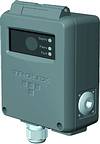

The TX6223 flame monitor from Trolex is intended for the monitoring of fire, flames and sources of heating or combustion in process plants, oil and gas platforms, open areas and storage areas. Overseeing and protecting machinery and conveyor systems, sensing the presence of flames, incendiary flames, sources of heat or incendiary sparks.
The monitoring circuit is 'solar blind' and capable of discriminating between genuine flame signals and spurious interference from light sources and sunlight. The flame sensor responds to broadband short-wave infrared flicker emitted from flames, burning embers and sources of combustion. It is unique in that it operates in the 1 to 2,8 µm band, enabling it to respond to all types of flames, irrespective of the source. Many flames, such as those associated with hydrogen and sulphur fires, are invisible to conventional flame sensors.
It incorporates two independent sensor systems, one covering the 1 to 1,5 µm band and the other operating in the 1,5 to 2,8 µm band, thus enabling virtually all forms of false alarm and spurious signals to be eliminated. There is a recognisable and exclusive relationship between the flicker frequencies emitted in the two operating bands when a flame is present. This is constantly monitored ensuring that the sensor only responds to flicker emitted from a genuine flame source, disregarding static radiation from adjacent warm objects.
Unlike other flame sensors using more traditional IR or UV technology, the special infrared sensors used in the TX6223 have a considerably longer operating life and are capable of sensing through glass and oil mist. Flame flicker analysis also makes the sensor tolerant of dust build-up, condensation and contamination.
The direct viewing angle of the sensor is an axial cone of about 90°C, but uniquely, it is the only sensor of this type that will also respond to reflected infrared radiation - in many cases, enabling it to detect flame sources over a full 360°C viewing zone. Even when monitoring large areas containing plant and machinery, hidden fires can be detected because reflected IR is capable of circumventing such obstacles. It also means that fewer sensors are needed to protect a given area compared to more conventional sensors that cannot respond to 'blind spots'. Sensitivity adjustment is provided so that the response can be set to suit prevailing operating conditions. In most installations, a single unit is adequate for complete protection, but two units may be used where critical operating integrity is required.
The output signal is fully compatible with all standard FIRE current loop input circuits and is a direct replacement for any model currently available. Up to 25 sensors can be connected onto a single alarm loop. The sensor can also be operated in conventional mode from a fixed 24 V d.c. power supply and it provides two output contacts, one to indicate flame and the other to denote a fault. In both operating modes, the alarm circuit will 'latch' and can be reset by momentarily interrupting the 24 V d.c. supply. There is an in-built three-second delay on the alarm to override the possibility of spurious signals.
The supply voltage to the sensor is constantly monitored and if it falls to a level that will not sustain correct operation, the sensor will disable itself. This feature can also be used to positively identify the location of a particular sensor in a group that has initiated an alarm. Each sensor also has a control input, enabling the alarm function to be tested from a remote push-button. An in-built infrared source simulates an alarm condition and also monitors the IR scanning system, giving a fault indication if the obscuring of the sensing window exceeds safe operating limits.
The sensor is fully EMC protected and is designed to be compatible with standard fire detection and alarm systems (EN54 Part 10 and BS5839 Part 7) with a choice of fully weatherproof housings manufactured in polycarbonate or polyester coated die cast zinc alloy. It is light and compact, easy to install, does not require special cabling or cable glands and is available with a swivel-mounting bracket.
The certified Intrinsically Safe version can be used in the highest category zone 0 hazardous areas. This means that the cover of the housing can be removed for maintenance purposes, without isolating the supply. It also means that the sensor can be replaced or installed without plant shutdown and there are no dangerous operating voltages involved.

© Technews Publishing (Pty) Ltd | All Rights Reserved